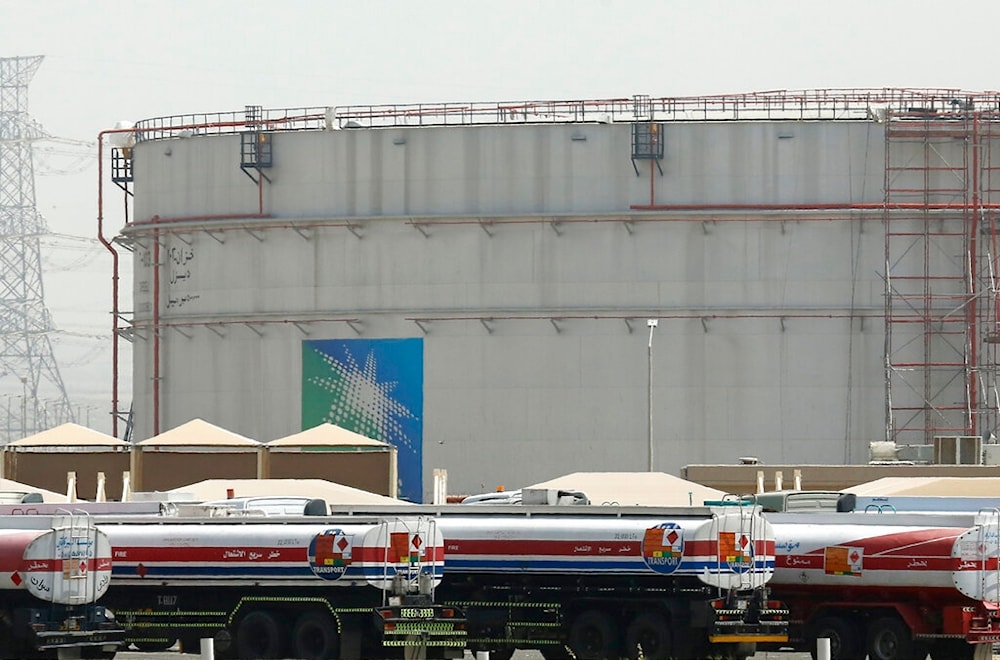Saudi Arabia posts $15.65 billion Q1 deficit as oil revenues fall 18%
Despite the oil-related revenue slump, non-oil income edged up by 2% to 113.806 billion riyals, reflecting incremental progress in economic diversification.
-

Fuel trucks line up in front of storage tanks at the North Jiddah bulk plant, an Aramco oil facility, in Jiddah, Saudi Arabia, on March 21, 2021. (AP)
Saudi Arabia reported a sharp increase in its budget deficit for the first quarter of 2025, reaching $15.65 billion, up from $3.3 billion a year earlier, amid falling oil revenues and elevated spending tied to its economic diversification agenda. The Finance Ministry attributed the shortfall to an 18% decline in oil income, which dropped to 149.810 billion riyals ($39.95 billion), and a broader 10% dip in total revenues to 263.616 billion riyals. Government expenditure, meanwhile, rose 5% to 322.317 billion riyals.
The financial strain comes as global oil prices remain under pressure. Brent crude fell over 1% last week to $61.29 per barrel, its lowest level in nearly four years, weighed down by oversupply fears, tepid demand, and uncertainty surrounding US trade policy. These market conditions have directly impacted Saudi revenues, despite efforts by OPEC+ to stabilize prices through coordinated production management.
In April, Riyadh and other OPEC+ members moved to accelerate the rollback of earlier voluntary output cuts. Production increases are set to begin in May, part of a phased restoration of 2.2 million barrels per day by November. The decision follows mounting internal tensions within the alliance, as Saudi Arabia has grown increasingly frustrated with members like Iraq and Kazakhstan over repeated quota violations.
"Saudi Arabia repeated its warnings against poor compliance on Saturday," a source told Reuters, noting Riyadh's insistence on burden-sharing within the bloc. Kazakhstan, in particular, has drawn criticism for exceeding its quota in April and signaling a preference for domestic priorities over OPEC+ commitments.
Read more: OPEC+ eyes full return of 2.2 million barrels amid compliance rift
These developments reflect the challenges Riyadh faces in maintaining fiscal balance while also preserving its leadership role within OPEC+. With a full-year deficit of 101 billion riyals forecast in the 2025 budget approved last November, the kingdom is relying heavily on debt markets to sustain strategic investments. Public debt climbed to 1.329 trillion riyals in Q1, yet Saudi Arabia retains a low debt-to-GDP ratio and remains one of the most active emerging market issuers globally.
Despite the oil-related revenue slump, non-oil income edged up by 2% to 113.806 billion riyals, reflecting incremental progress in economic diversification. "Boosting non-oil economic growth remains a top government priority," the ministry affirmed, highlighting continued efforts to attract investment into tourism, logistics, and the private sector under the Vision 2030 framework.
Read more: US to offer KSA $100 billion arms deal during Trump visit: Reuters
The shift in oil strategy, from stabilizing prices to reclaiming market share, also suggests a broader recalibration. Analysts warn that unless compliance improves within OPEC+, the full 2.2 million bpd of voluntary cuts could be unwound, potentially introducing further price volatility and complicating Saudi Arabia's fiscal outlook.
With a full OPEC+ ministerial meeting set for May 28, all eyes are on whether Riyadh can secure greater cohesion within the alliance while managing the domestic financial pressures of its ambitious transformation agenda.

 3 Min Read
3 Min Read








